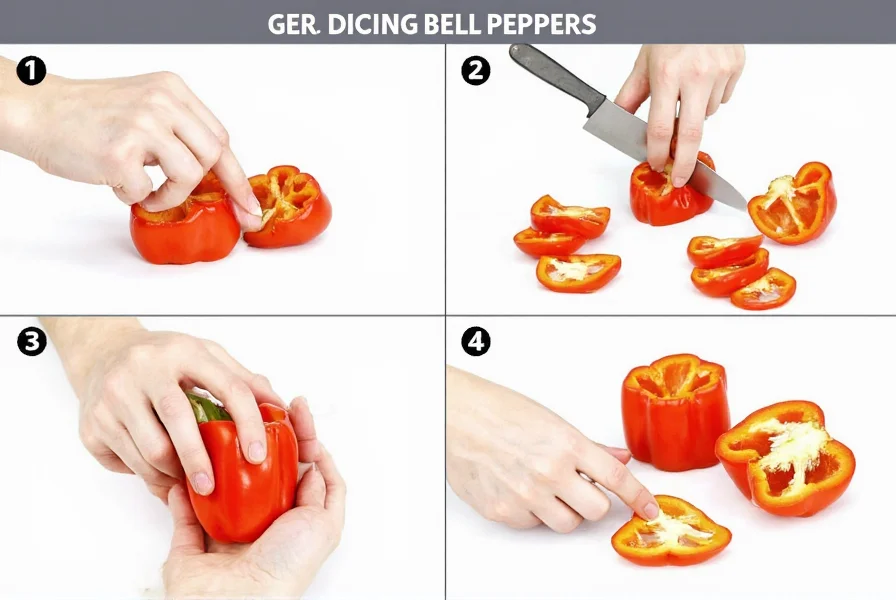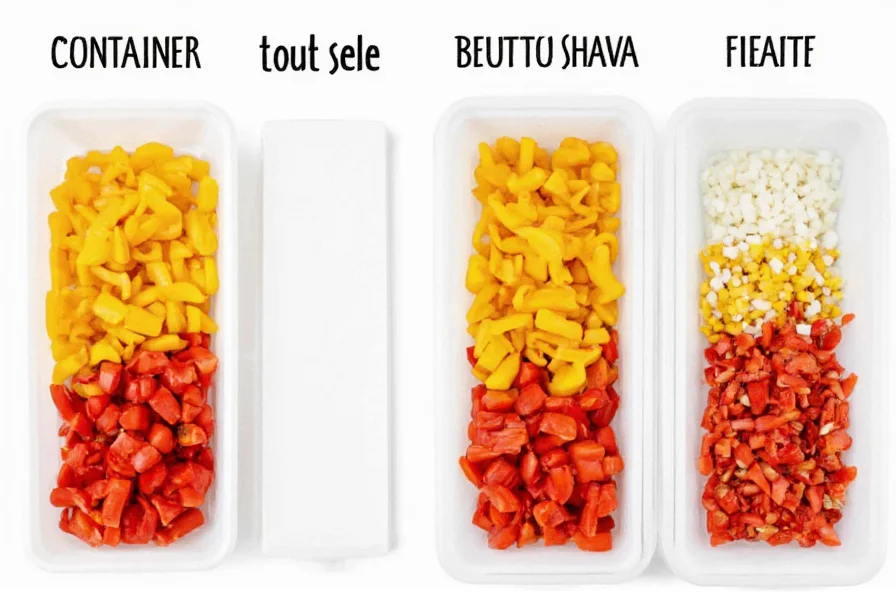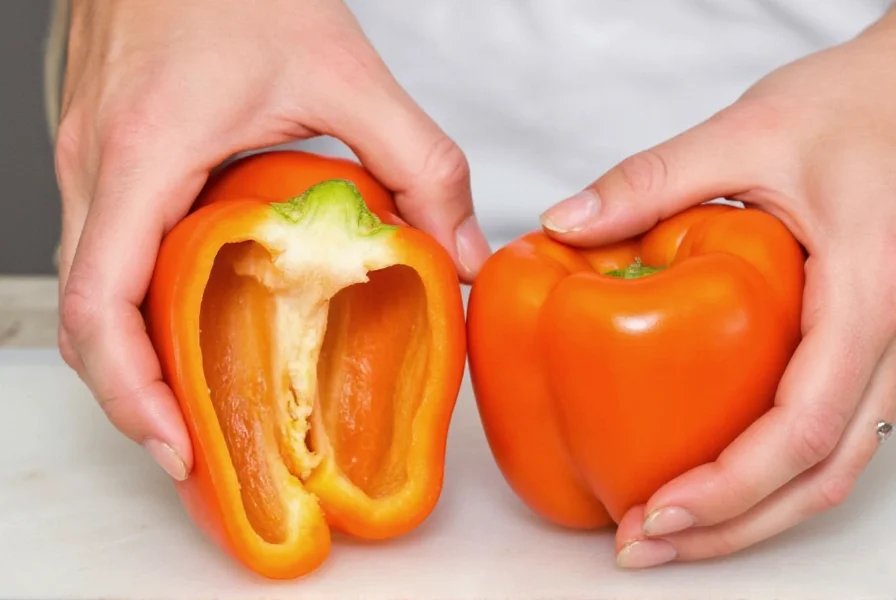To dice a bell pepper properly, first cut off the top and bottom, then slice vertically to remove the core and seeds. Lay the pepper flat, cut into uniform strips, then rotate and slice across to create even cubes. Use a sharp chef's knife on a stable cutting board, keeping fingers curled away from the blade for safety. This technique ensures consistent pieces that cook evenly in recipes.
Dicing bell peppers correctly transforms your cooking experience. Many home chefs struggle with uneven pieces or accidental cuts, but mastering this fundamental kitchen skill takes just minutes to learn. Whether you're preparing fajitas, stir-fries, or salads, properly diced bell peppers enhance both presentation and cooking performance.
Why Proper Bell Pepper Dicing Technique Matters
Uniform dicing isn't just for professional chefs. When bell pepper pieces are consistent in size, they cook at the same rate, preventing some pieces from becoming mushy while others remain crunchy. This precision technique also maximizes flavor distribution in dishes and reduces food waste by ensuring you use every edible portion of the pepper.
Essential Tools for Dicing Bell Peppers
You don't need specialized equipment for this basic kitchen technique. A sharp 8-inch chef's knife provides the perfect balance of control and efficiency for dicing bell peppers. Pair it with a stable, non-slip cutting board—wood or high-density plastic works best. Keep a small bowl nearby for seeds and membranes, and have dry hands to maintain a secure grip on the pepper.

Step-by-Step Guide to Dicing Bell Peppers
Follow these professional kitchen techniques to dice bell peppers safely and efficiently:
- Prepare your workspace: Wash and thoroughly dry the bell pepper. Moisture makes peppers slippery and dangerous to handle.
- Cut the ends: Place the pepper vertically on your cutting board. Slice 1/4 inch from both the stem end and blossom end.
- Remove the core: Stand the pepper upright on one cut end. Carefully slice downward along the natural curves to separate the pepper walls from the central core and seeds.
- Flatten the sections: Lay each pepper section skin-side down. Trim any remaining white pith from the inside.
- Create uniform strips: Make vertical cuts parallel to the long edge, creating even strips about 1/4 to 1/2 inch wide depending on your recipe needs.
- Dice the strips: Gather the strips together and cut horizontally across them at the same width to create perfect cubes.
Safety Tips for Dicing Bell Peppers
Knife safety should always be your priority. Keep your non-knife hand in the "claw grip" position—fingertips curled under, knuckles guiding the knife edge. Always cut away from your body, and never try to catch a falling knife. If you're new to this technique, practice with slower, deliberate movements until the motion becomes natural. Remember that a sharp knife is actually safer than a dull one, as it requires less force and is less likely to slip.
| Common Mistake | Professional Solution |
|---|---|
| Slippery pepper causing uneven cuts | Dry pepper thoroughly before cutting; use paper towel if needed |
| Inconsistent dice sizes | Measure strip width with your knife tip before final cuts |
| Pepper pieces sticking together | Separate strips with your non-knife hand before dicing |
| Wasted edible portions | Trim only necessary white pith; most inner membrane is edible |
Storing Diced Bell Peppers Properly
Properly diced bell peppers maintain freshness for 3-5 days when stored correctly. Place them in an airtight container lined with a paper towel to absorb excess moisture. Store in the crisper drawer of your refrigerator. For longer storage, spread diced peppers in a single layer on a baking sheet, freeze until solid, then transfer to freezer bags. Frozen peppers work well in cooked dishes but lose crispness.

Advanced Techniques for Specific Recipes
Different dishes require different dice sizes. For salsas and salads where texture matters, aim for 1/4-inch brunoise cuts. When preparing peppers for stir-fries or fajitas where they'll cook quickly, 1/2-inch dice works best. For stuffed peppers or dishes where appearance is critical, take extra care to maintain uniform shape throughout the process. Remember that red, yellow, and orange bell peppers tend to be sweeter than green varieties, which can influence your recipe decisions.
Frequently Asked Questions
Can I dice bell peppers without removing the seeds first?
While possible, it's not recommended. Seeds and white membranes create uneven texture and can become bitter when cooked. Removing them first ensures consistent flavor and texture in your diced peppers. The proper technique for dicing bell peppers always includes seed removal for best results.
What's the fastest way to dice multiple bell peppers?
Process peppers in batches: cut all tops and bottoms first, then remove cores from all peppers, followed by flattening all sections, and finally dicing. This assembly-line approach saves time while maintaining consistent dice size. Professional chefs often use this method when preparing for large recipes.
Why do my bell pepper pieces keep sticking together when I dice them?
This happens when the pepper strips aren't properly separated before the final cross-cuts. After creating your vertical strips, gently separate them with your non-knife hand before making horizontal cuts. Dry hands and a dry cutting board also prevent sticking, as moisture causes pieces to adhere.
Does the color of bell pepper affect dicing technique?
The basic dicing technique remains the same regardless of color. However, riper peppers (red, yellow, orange) tend to be softer and more delicate than green peppers, so use slightly lighter pressure with your knife. All varieties follow the same step by step bell pepper dicing instructions for best results.











 浙公网安备
33010002000092号
浙公网安备
33010002000092号 浙B2-20120091-4
浙B2-20120091-4